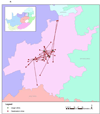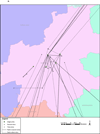Mobility and Clinic Switching Among Postpartum Women Considered Lost to HIV Care in South Africa
- PMID: 28225717
- PMCID: PMC5324708
- DOI: 10.1097/QAI.0000000000001284
Mobility and Clinic Switching Among Postpartum Women Considered Lost to HIV Care in South Africa
Abstract
Objective: Retention in HIV care, particularly among postpartum women, is a challenge to national antiretroviral therapy programs. Retention estimates may be underestimated because of unreported transfers. We explored mobility and clinic switching among patients considered lost to follow-up (LTFU).
Design: Observational cohort study.
Methods: Of 788 women initiating antiretroviral therapy during pregnancy at 6 public clinics in Johannesburg, South Africa, 300 (38.1%) were LTFU (no visit ≥3 months). We manually searched for these women in the South African National Health Laboratory Services database to assess continuity of HIV care. We used geographic information system tools to map mobility to new facilities.
Results: Over one-third (37.6%) of women showed evidence of continued HIV care after LTFU. Of these, 67.0% continued care in the same province as the origin clinic. Compared with those who traveled outside of the province for care, these same-province "clinic shoppers" stayed out-of-care longer {median 373 days [interquartile range (IQR): 175-790] vs. 175.5 days (IQR: 74-371)} and had a lower CD4 cell count on re-entry [median 327 cells/μL (IQR: 196-576) vs. 493 cells/μL (IQR: 213-557). When considering all women with additional evidence of care as engaged in care, cohort LTFU dropped from 38.1% to 25.0%.
Conclusions: We found evidence of continued care after LTFU and identified local and national clinic mobility among postpartum women. Laboratory records do not show all clinic visits and manual matching may have been under- or overestimated. A national health database linked to a unique identifier is necessary to improve reporting and patient care among highly mobile populations.
Conflict of interest statement
The authors declare no conflicts of interest.
Figures





References
-
- Republic of South Africa Department of Health. Implementation of the Universal Test and Treat Strategy for HIV Positive Patients and Differentiated Care for Stable Patients. 2016
-
- Joint United Nations Programme on HIV/AIDS (UNAIDS) Global Report: UNAIDS Report on the Global AIDS Epidemic 2013. 2013
-
- Statistical Release: Mid-Year Population Estimates. Pretoria: 2015. Statistics South Africa.
MeSH terms
Substances
Grants and funding
LinkOut - more resources
Full Text Sources
Other Literature Sources
Medical
Research Materials

